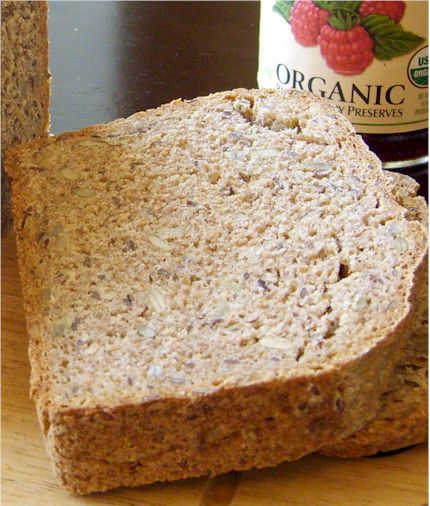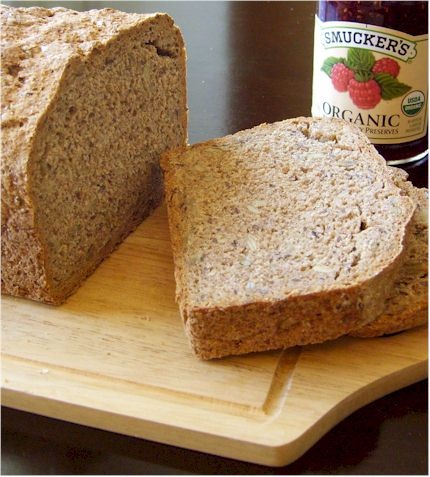With the economy in what seems to be a neverending tailspin, I have seen many, many people turning to home-baked bread. I’m fortunate to have a bit of head start in this department. This whole grain bread recipe is just one of the many I have mixed, kneaded, and baked over the years.

Years ago, finding dairy-free loaves of bread in the stores was no easy feat; most contained milk in some form, whether it was milk powder, whey, butter, cream, or plain old nonfat milk. Not willing to give up sandwiches and toast, I started baking bread from scratch, constantly in pursuit of the perfect whole grain bread recipe. Since those early days, some good brands of bread have emerged which are in fact dairy-free, but I stick to homemade. Both my husband and I agree that it tastes infinitely better, and it is still much less expensive. Plus, it gives me control over the ingredients used.
When you are first starting out, baking bread can seem intimidating, but recipes like this one are so simple that you will wonder why you didn’t begin baking your own bread long ago.

Special Diet Notes: German-Style Whole Grain Bread Recipe
By ingredients, this recipe is dairy-free / non-dairy, egg-free, soy-free, peanut-free, nut-free, vegan, plant-based, and vegetarian.
- 2 Cups Warm Water
- 3-1/2 Teaspoons Active Dry Yeast (just over 1-1/2 .25-ounce packages will do)
- 5-1/4 Cups Whole Wheat or Whole Spelt Flour (or a combination of the two)
- 2-1/2 Teaspoons Salt
- 2 Tablespoons White or Apple Cider Vinegar
- 1 Cup Seeds (I use ⅓ cup each of sunflower, pumpkin, and flax seeds)
- In a large mixing bowl, dissolve the yeast in about ½ cup of the water (no need to be exact, you will be adding the rest of the water shortly).
- Let that rest for a few minutes while you grease a 9 x 5 inch loaf pan.
- Sift the flour and salt into the bowl. Add all remaining ingredients (rest of the water, vinegar, and seeds), and mix until a relatively smooth dough is formed. Mine was still a touch sticky, but still able to be handled and formed without completely sticking to my fingers.
- Form the dough into a loaf shape that will fit end to end in your pan. I just sort of shape it, and then roll it a few times on the counter to make it look a little nicer and be the right length.
- Lightly cover the loaf with saran wrap or a tea towel, and let it rise in a relatively warm, draft-free place, for about an hour to an hour and a half. It should double in size and fill out the pan nicely.
- Preheat your oven to 480ºF (250ºC). Bake the loaf for 15 minutes, reduce the heat to 390ºF (200ºC), and bake it for another 45 minutes.
- Remove the loaf from the pan (it should pop right out), and knock on the bottom. If it genuinely sounds hollow, then it is done. If you think it needs a little more time, pop it back in the oven and bake it for longer as needed. My loaf was done after the initial hour, but you may need another 10-20 minutes, depending on moisture and such.
This recipe is Vegan, Vegetarian, Dairy free, Egg free, Nut free, Peanut free, Soy free, Sugar free, and Low fat.

18 Comments
No need to kneed??
I mix / knead just until a relatively smooth dough forms. This can take about 5 minutes.
I love making bread and still kinda feel new to it. I recently married a german and want to make bread that he ooohs and ahhhs for. I’ve figured that around 2-4 cups of flour per loaf for perfectly for our toaster soooo when I read that yours was over 5 cups for 1 pan I was surprised but wanted to try it! Haha, after it had risen 30 minutes I knew i had to divide it into 2 loaf pans. They’re looking good and am about to put them in the oven. Thanks for the recipe!!
It does make a big loaf! Glad you are enjoying it, and thank you for your feedback.
Hi, i’m really looking forward to tasting this – just got it out of the oven! I am wondering if this recipe could be used in a breadmaker? I’m thinking, put it on a timer overnight and have it ready in the morning? Thanks in advance!
Hi Dan, I haven’t tested it in a bread maker – it’s actually a bit difficult for me to test for the bread maker as we live at slightly high altitude, making for fussy results in that enclosed environment. If you do get the chance to trial it, I would love to hear how it works out for you!
Well I’ll give it a go and let you know how I get on! Thanks
Great, thanks Dan!
Hi ! Can I substitute some dark rye flour in the recipe?! I’m anxious to try the recipe! Thanks
I haven’t tried it, but imagine that would work!
Pingback: Wholemeal bread with pumpkins seeds | What Catherine ate next
Delicious! We’re enjoying a piece right now, fresh out of the oven. I have been wanting to start making bread instead of buying it, but it seemed to complicated. Your recipe was easy and came out great! The crust is a bit hard on mine though, is that normal? Either way, I’ll be making this many more times! Thank you for sharing! 🙂
That’s awesome! So glad you are enjoying it Bianca. Yes, some whole grain breads have a thick crust. I like them this way. But you can soften them a bit by basting with a little oil or margarine prior to baking and/or just as you remove it from the oven (while still hot).
Hi Alisa – sorry if this is a silly question, I have never made bread before. May I ask what you use to grease the pan?
Hi Greg, your favorite baking oil, cooking spray, or dairy-free margarine will work fine!
I just made this without the seeds, and it’s delicious. I was worried that the bread would be dry since there is no added fat, but it’s quite moist. I’m serving the bread tonight with homemade potato soup! Yum.
Flax seeds should not be heated.
Heat alters them and makes the flax seeds do more harm than good
Actually, flaxseed oil should not be heated, but studies have shown that flax seeds do not degrade in baking, so enjoy! – http://whfoods.org/genpage.php?tname=dailytip&dbid=18